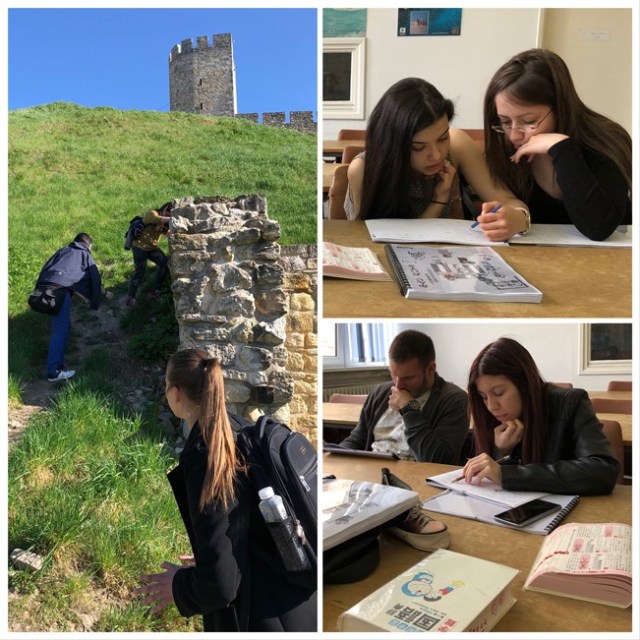2019 Activity Report
March Activity Report
31 March 2020
Global Japan Office Coordinator
Amari Mino
The impact of the new coronavirus on Serbia has been extremely large, and is perhaps the only time de facto martial law has been imposed on Europe, effectively putting the whole country under military rule. These measures are probably the best solution for a country that is extremely vulnerable in terms of medical care, but if you take one step outside, the beautiful cherry blossoms of Serbia are in full bloom as usual, so they have created an extremely difficult environment for the people, international students and teachers. However, until that day, which came like a bolt from out of the blue, it was a very calm and pleasant spring. And there were some great events. I would like to tell you about those happy days.
◆Japan Bowl Balkan
This year, the University of Belgrade began with a special shift in the semester. Therefore, the Japan Bowl Balkan held in March was held on March 1, two weeks earlier than usual. You could say that this was very lucky.
Last year’s third Japan Bowl ended with great success, but there were some problems, such as unnatural sentences, and there were also many problems that were very advantageous for students in the literature department. Because it was originally an American event, and licensed, I was concerned that it would have to be localized for the Balkan situation.
Therefore, from this fiscal year, we have organized our own task force, which consists of two Japanese people and one Serbian, to create problems that are more specific to the Balkans than the problems on the American side, as well as problems that are more natural to Japan, so that the participants and viewers in the Balkans can enjoy them more than anything else. In order to do this, we continued to work for more than a week, during which we almost always stayed up all night, but as a result, we are very happy that the Balkan Games will be a truly enjoyable event for everyone.
This year, two teams of high school students participated, and thanks to the support of the Japan Foundation, the participants from the Balkans were able to continue to receive transportation expenses, so it is worth noting that we were able to attract a wide range of participants. As the tournament has become more widely recognized in the Balkans, the number of sponsorships by Japanese and local companies has increased, and it is expected to become an enjoyable event that can be expected to grow in the future.
The Japan Bowl has tough qualifying rounds starting in the morning. There are about 20 teams in the tournament, but only three of them can make it to the finals. Although it was a very narrow gate, all the participants tried hard while also having both fun and a few problems. Even in the qualifying rounds, participants were given souvenirs and certificates, so it was a very satisfying morning session.
We were able to spend a fun lunch time leisurely by distributing lunch boxes and setting up a sushi bar and cake bar stocked by the local store, GO Sushi. People at the Japan Bowl come from all over the Balkans, so it’s a great place to socialize. Nothing is more wonderful than meeting and socializing with a variety of people.
Then in the afternoon, it was finally time for the main competition. The main competition moved to the largest auditorium, which has a dignified capacity of nearly 600 people. Three teams were selected here and competed in riveting rounds.
In addition to this, various events were held at the same time, including a demonstration of aikido by a group of Serbs, a choir, and a Japan Bowl dance by people wearing a yukata. It’s not just a quiz contest, but also an enjoyable event. It was a lively place where people who were interested in Japanese culture gathered, and it seems that the enthusiasm for Japan among the people who were there grew even higher.
Of course, for Japanese people who attend this event, it is a place to be moved. It is very rare for me to have the chance to realize that so many people love Japan. I felt like I was enchanted by the enthusiasm that was poured over us, which made me feel proud, and also a little embarrassed.
In the end, this year, a third-year student defeated a fourth-year and won the championship. As a matter of fact, this third-year student has been attending my free private lessons. Of course, none of the competition questions were revealed in advance. All I know is that they won due to their love for the Japanese language. As a teacher, it was extremely rewarding to see this student’s passion come alive on such a grand stage.
Of course, all of my students are important to me. Nevertheless, I feel that it is my mission to support students who strive to be even better. Although it was at a quiz competition, I was very happy to see this student’s efforts displayed in a visible form. To tell you the truth, I was nervous at times. When they had trouble solving grammar problems, I was really nervous, and wondered if my teaching methods were bad. By being able to see the results in front of my eyes, I could make positive changes in my classes.
The Japan Bowl is a very long and big tournament, including the preparation for it, the actual performance, and after. It’s a tournament that is made up of many volunteers. I pray that such a tournament, one which we can all work together on to hold successfully, will continue in the future, and I firmly hope that the Serbs will be able to overcome the difficult current national situation, and that we will overcome it together.
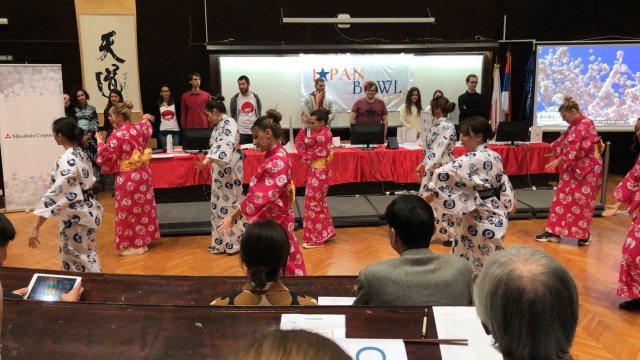
February Activity Report
29 February 2020
Global Japan Office Coordinator
Amari Mino
It snowed for the first time this year in February. This winter is really strange. The persecution of Asians (mainly Chinese and Japanese) due to the new coronavirus that has been spreading since the end of January seems to be getting bigger day by day. In late February, I took a minibus (it’s like a shared taxi in Japan) to Budapest to attend a workshop on Japanese language education in Central and Eastern Europe. At a border crossing in the middle of the night, a man looked at me, yelled “Chinese and Japanese, those who came within the last two weeks, get out! Go to the airport!” and they wouldn’t even look at my passport. Of course, I had been traveling around the world, and there was no reason for me to timidly retreat at such an extraordinary pace, so I shouted back, “I’ve been living in Serbia! Look at my passport!” and I was finally able to cross the border. But what happened to those who couldn’t say so? How in the world could they even get to a faraway airport in the middle of the night if they’re down at the border? We’re on the verge of becoming refugees. By the way, on my way home, I was able to take a minibus with my Serb friends from Budapest, so I was able to pass easily. “Come on, you’ll be fine with me!” my friend said confidently.
◆Guests from Japan
February in Serbia is the beginning of the school year. Every year, a lot of Japanese people visit the University of Belgrade around this time, as it’s usually spring vacation at Japanese universities.
It is also a very important time to have such people talk to us and have them hold workshops during our club activities and classes. After all, in Serbia, where there are less than 200 Japanese people, it is one of the few opportunities for students to get in touch with Japanese people and communicate in the Japanese language that they are learning every day.
This year, as usual, my senior, Mr. TAKAHASHI Wataru, who originally taught Japanese at Belgrade University, came to see us. Although the semester had not yet started, many students attended Professor Takahashi’s seminar.
The guest from Japan got a great reception, and even the students who tend to skip the reading club hurriedly came and enjoyed it. Of course, this was mostly because of Professor Takahashi’s wonderful smile and teaching method.
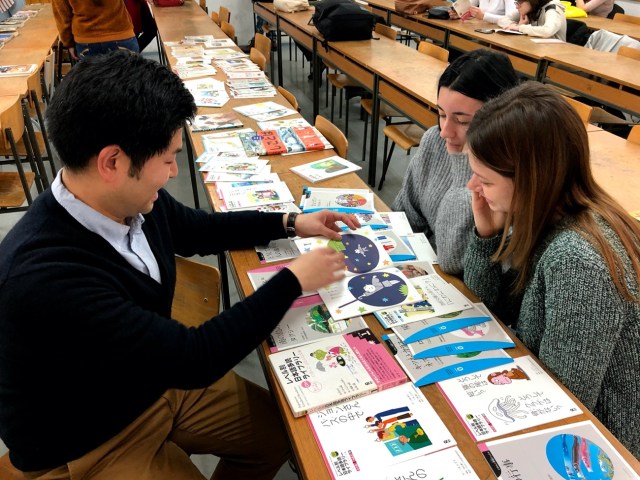
Many other workshops were also held.
In particular, there were many held after the end of the month, including one by NAKAGAI Takako from Toyooka City (Hyogo Prefecture), who visited a Japanese language class to talk about the revival project of Kounotori in Toyooka City, seasonal trends, and the Doll Festival. They prepared a lot of souvenirs for the students, but unfortunately their luggage was lost in transit, so she couldn’t give them out during her visit, but the students were deeply moved by the thoughtful souvenirs when I handed them out in a later class. Although Ms. Nakagai got a Japanese language teacher’s license at university, she never had the chance to teach Japanese language classes. This was her first time teaching a Japanese language class, and it was impressive, so I was very moved.
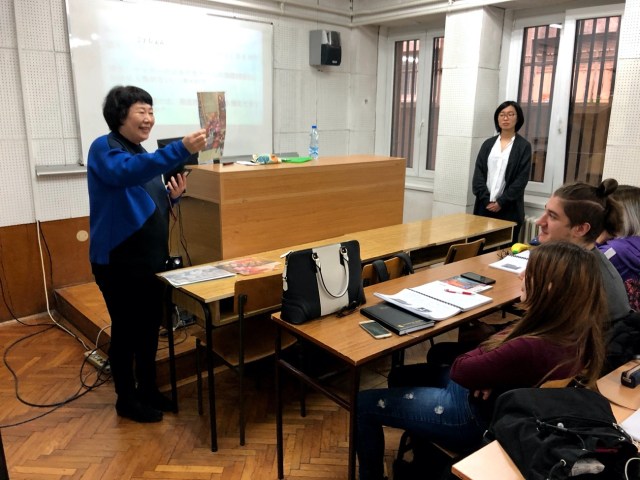
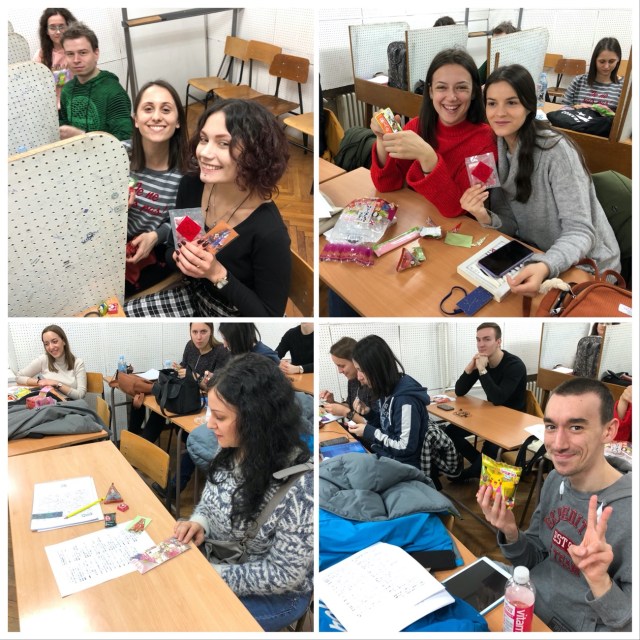
Professor LEE Jae-ho from Waseda University also gave a special class called “What is a good article?” and the students were quite happy with this interesting interactive class. Even the first-years, who are still just beginners, participated, and I was very happy that they were motivated to learn and that they said things such as “I didn’t understand at all, but I want to ;earn to understand from now on!”.
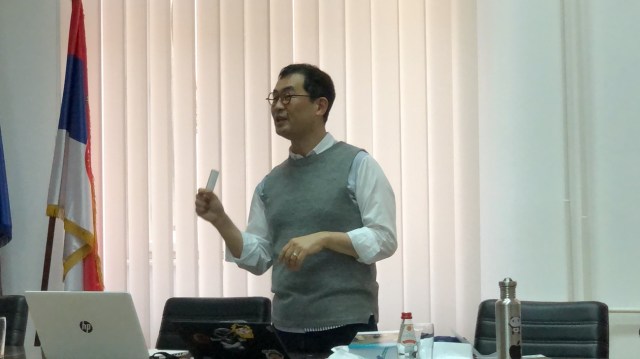
Ms. Nishinaka Junko, a JICA Senior Volunteer who works for welfare facilities for persons with disabilities in Serbia, held a workshop. She actually brought us cookies made at a welfare facility for the disabled, which the students ate together after her talk. We then wrote messages in Serbian to the people at the facility who made the cookies. Later on, I heard from Ms. Nishinaka that the people at the facility were deeply moved by their heartfelt messages, by which in turn I was also deeply moved as an educator.
A spokesperson from Waseda University also came to cover the class for media purposes, and I was surprised and very pleased to hear that the internship program here at Belgrade University was the most popular among Waseda students.
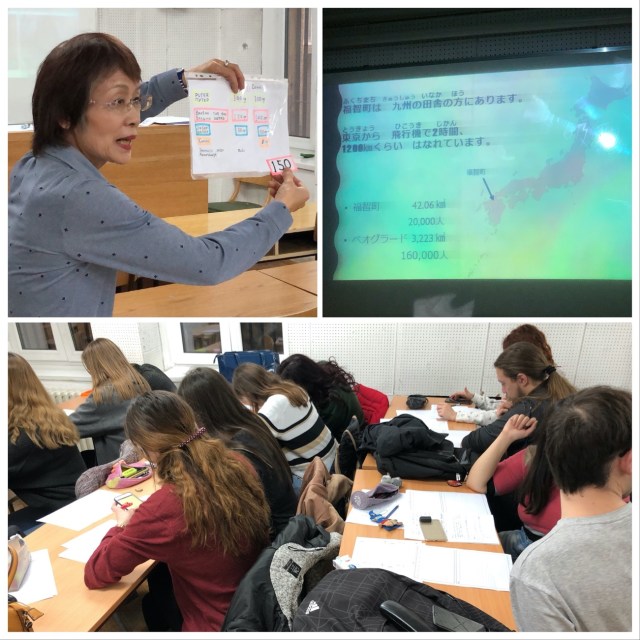
There were still many more workshops. Ms. KANBA Naoko (Japanese language teacher and founder of an online Japanese language school), who came from Japan on a privately-funded internship, held a kimono workshop for two days. Curious students watched her going through the process of putting on a kimono. And the end there was a photo session. My heart dances whenever I see students looking really happy.
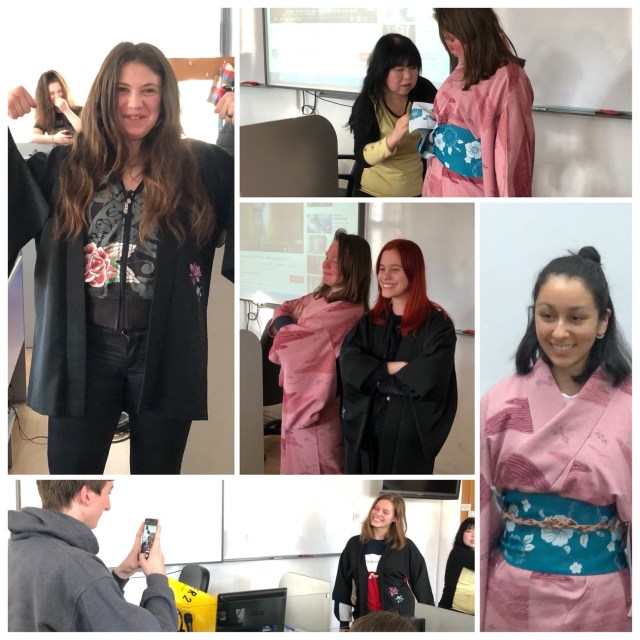
Finally, I would like to talk about the study tour with Keio University, which happens once a year. Students from Keio University visited twice last year, and this was their first visit this year. All the members of this study tour were fresh faces, but the Serbian students always enjoy themselves every time as if they were meeting old friends. Nothing is more wonderful than being able to actually talk to students of your own generation in the language you’re struggling to learn.
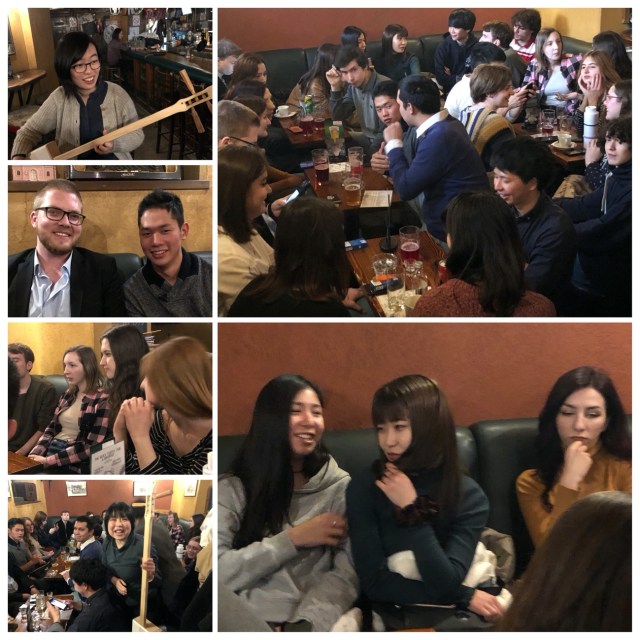
Actually, there were also many other events in February. I was able to meet Prof. Sukero Ito again in Budapest and get to know and talk with many people.
Due to recent circumstances, my mother passed away right after the start of the new semester, although this was a personal matter. It was the end of my 16 years of caregiving and, when I came to Serbia, I talked with my mother about this kind of situation. What my mother told me at that time was that no matter what, I should put my students first, and that I didn’t have to go back to Japan. Holding these words to my heart, I was able to spend these beautiful and enjoyable days with my students in Serbia. I told the students about this honestly. Every day in February, I was so busy that I didn’t even have time to sleep. Having directly accepted my mother’s wishes, I worked from Serbia every day to go through the procedures for her death in Japan together with my older sister. I would like to take this opportunity to express my heartfelt gratitude to all the students and all those involved who have transformed these crazy days into memories of such a colorful life.
January Activity Report
31 January 2020
Global Japan Office Coordinator
Amari Mino
This winter is as warm as ever. Now, it will most likely only snow after February when one of my students, who I think brings good weather wherever she goes, returns to Japan! That’s the prediction we’ve made. Although January is warmer than usual, rumors of a new coronavirus are spreading in Serbia. At the end of the month, when I got on a bus or something, elementary and junior high school boys looked at me and started singing a song about corona. I grew up with a relatively large number of foreigners since I was a child, so I didn’t even realize that I look Asian, so this was quite a shock. I hope this pandemic will improve soon ......
◆My Beloved Serbian dishes
When you travel abroad, do you look forward to the local cuisine? Or are you the type to bring a lot of soy sauce, miso, and Japanese pickles in your suitcase to eat when you miss the Japanese taste?
I’m actually quite the former.
When I was growing up in the 1970s, traveling abroad was still very rare. My father, who had traveled around the world, was a big fan of “Kaoru Kanetaka’s World Trip” which was shown on Sunday mornings, and I used to watch it with him every Sunday morning.
My father told me that, “if you want to be able to live anywhere in the world, you need to be able to enjoy whatever you have there!” and made me practice this philosophy. This essentially means “if you go to the place where you eat insects, eat insects”.
That’s why I’m not picky. There are some things I don’t like. For example, I can’t drink large quantities of alcohol, but so far there hasn’t been an alcohol that I couldn’t stomach. That’s why I can enjoy Serbian Lakia so much.
Now, did you know that the dining system at the University of Belgrade in Serbia is quite interesting? If you are acquainted with students or a teacher, you can eat there, so I recommend it. Also, if you stay in the dormitory as a tourist, you can buy a ticket for about 100 yen to eat there. A dormitory student can eat a meal for about 70 yen.
First of all, there are about 10 dorms, and there are differences in the menu and taste of each dorm’s cafeteria, so it is fun to visit the cafeterias of each dorm. The rules for taking menus are also slightly different, which may be confusing at first, but gradually you will be able to enjoy these differences. You’ll also find your favorite dorm restaurant. Most of the time, you get used to the taste of the dormitory you live in, but there are some menu items only on offer in certain dormitories, so it’s fun to eat your way around. In addition to the dormitories, there is a cafeteria for university students near the university. We call these cafeterias Menza, so ask where the Menza is. Since Menza are usually inside the dormitory buildings, it is very difficult for first-timers to find them. I actually recommend going with other students.
Since I came to Serbia, I have really only been eating Serbian food. Sometimes I eat Japanese food, but I have never been to a Japanese restaurant in Serbia. That’s how much Serbian food suits my taste.
Serbian food is, after all, fresh and natural. This also means that it’s easy for the food to go stale, but this is only a matter of time of course, as with all fresh ingredients. They’re natural and don’t contain any additives to make them keep longer.
I heard this story from two Japanese people. One was allergic to pork and the other was allergic to beef. However, for some reason, they can eat them in Serbia and don’t get allergic reactions. I guess it was not an allergy to meat but an allergy to something else. Serbia is a country where you can get such pure ingredients, so there’s no way that the food using them isn’t delicious. Please enjoy Serbian cuisine.
However, when it comes to pure Serbian cuisine, there’s surprisingly few dishes. Of this I am almost certain. Serbian cuisine has developed by incorporating cuisines from various regions as a result of interaction with said regions. When people from other countries come to Serbia, they will surely notice that there are dishes from their own country. In other words, it can be said that Serbian food is made up of the best ingredients of various countries.
I enjoy Serbian food in this way, but many Japanese people seem to have what I call “I want to eat Japanese food disease”. At first you can enjoy Serbian food, but after a while you start to miss Japanese food. Rice is better than bread. Rice should be chewy like in Japan ....... In Serbia, rice is served as a vegetable on the table almost every day, so you can eat it often, but since the type of rice is completely different from that in Japan, it doesn’t seem to suit the taste of Japanese people. Macedonian rice is popular among them. It seems to be close to the texture of Japanese rice. I have had it before, but my impression was that it is not so similar and it is not something I would choose to eat. I’m sorry to those who have offered it to me.
When I tell Serbs that I eat only Serbian food in Serbia, they are always surprised and ask the same question.
“So, which Serbian food do you like best?”
Well, it’s pretty hard to answer this question. I like all of them. So I always answer like this.
“If I must choose, I’d say bread and milk are the best!”
When Serbs hear this answer, they look happy and satisfied.
It is probably the same thing as when a Japanese asks a foreigner a similar question and gets a reply of “rice and miso soup!”.
I’m not saying this to be polite. Serbian bread and milk are really delicious! Especially the warm milk served at breakfast in winter! Every time I eat bread, I picture a vast wheat field in front of me. For me, there are few countries where basic food is as delicious as this. Serbian bread and milk alone are enough for me to survive.
When I lived in Japan, I always ate ‘natto tamago kake gohan’(natto and egg on rice) every morning. For me, it is the best breakfast in Japan.
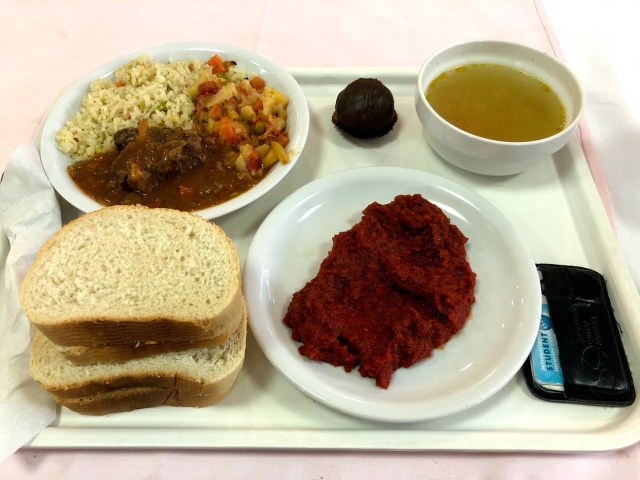
December Activity Report
31 December 2019
Global Japan Office Coordinator
Amari Mino
Winter this year has been a bit odd. Usually, snow starts to pile up around mid-November, but this year it hasn’t at all. No matter how long it snows for, it just doesn’t pile up. It has been a surprisingly warm winter, and from what I’ve heard it’s been the same for all of Europe, and even Japan. On the other hand, I heard from someone living in Canada that it has been awfully cold there. It seems the earth’s temperatures are struggling to balance each other out.
◆The difficulty of exams and evaluations
This time, I’d like to talk about the concept of exams.
An exam is basically an evaluation. Some exams don’t have much affect on how a student is evaluated, but there is still nothing that makes students more nervous than exams.
The university I graduated from was quite peculiar in this regard. By the way, this was not TUFS. The first-year civil law class exams were particularly interesting. After learning about civil law for a year, the final exam set one question only: “Discuss the term shakuhishougi” (“sticking to the rules”). At first I panicked, but after taking deep breaths and thinking about it, I realized what a great question it was. This is this kind of education I experienced at university.
Exams look a little different here at the University of Belgrade. In addition to having two midterm exams (colloquium) a year, they also have final exams six times a year. Last year, after students strongly insisted, one more final exam was added. The Japanese department exams are relatively easy, so they didn’t really insist, but the other language department exams are quite difficult. Many students pass the Japanese exam, but fail the Serbian grammar exam. Students who couldn’t pass an exam after six tries banded together to attempt the seventh, and it was a scene I couldn’t possibly imagine seeing in Japan. But this is Serbia, this is the norm.
While last year I looked on at the seventh-round of exams as if they were someone else’s problem, the time finally came for me to prepare a seventh exam.
This happened during December’s colloquium.
While the textbooks were changed this year, I had to take the old students (the students repeating a year) into account when making the exam, so it was a very difficult time. They generally only revise the things they have learnt in class, so they can’t attempt questions on anything else.
It was mentally tiring to create a test based on two different textbooks. If I made questions based on the new textbook, the old students wouldn’t be able to answer them, and if I made questions based on the old textbook then there would be no point in having a new textbook.
I decided to make 10 kanji reading and writing questions based on what they learnt in the lower year-levels. Basically, it was revision for what they learnt over a year ago.
From my perspective this was like giving them free marks, but the results actually went in the opposite direction.
Of course, the top students were able to answer these without issue. They scored some really good marks. The problem was the below average-range students. They couldn’t even write the kanji for “typhoon”, which they had learnt the previous year. Many students wrote “大風” instead of “台風”, and that word does exist in the dictionary, so I gave them points for it, but I was still quite shocked. Typhoons and Japan are inseparable, so not even being able to write that… exactly how many years have they been studying Japanese?
There were also other issues, so they didn’t do well at all. I guess they only know what’s in the textbook after all. A kanji list from the textbook was being passed around, so many students only studied using this. Afterwards, I got someone to secretly show me this list. It was full of difficult kanji, and the easier kanji that I chose for the exam had been left off.
Usually, the exam would be over by now, but this is Serbia, Serbians always try to negotiate.
The fourth-year students in particular were angry and appealed to the other teachers about my “reckless actions”.
“The way Amari-sensei makes exam questions isn’t the normal Serbian way!”
That was their reasoning.
In other words, they claimed that the “Serbian way” for teachers means only putting certain things in the exam, and for students means memorizing this list so you can easily get the marks.
I stood my ground and said “I included kanji that is lower than your current level, so if you couldn’t remember them, then why are you studying Japanese?”
They responded “this is our university, so you should do it the Serbian way!”
After talking for a long time about my thoughts on studying and language learning, all but one of my students came around. This student really couldn’t understand my point of view.
I also made a promise to these students. In particular, I made it for this one student.
“In the next final exam, I will do things your way. If I do this, you said you will all get full marks, right? Please keep this promise.”
As a result, hardly any students got all the kanji questions correct. The students who got high scores were the students who always do so no matter what kind of questions I give them. The students who claimed they’d get full marks if I only used kanji from the list only managed to get 60% of the questions right. Despite this, they were smiling as if they’d gotten 100%. I suppose it’s because with this mark they can advance to the next year-level.
This is the Serbian way that I ought to love. You may wonder what exactly about it am I supposed to love, and you may think it’s excessive, but intense negotiations are the Serbian way. Despite everything, I think it’s a very interesting way of thinking.
One time, a student said to me “Sensei, in Serbia, the first person to stop talking in a discussion or argument loses”.
I understood this, as I never say “okay sure” and back down without saying anything.
I always explain my thoughts and try to persuade the other person until they grow tired.
For Serbians, this kind of person is probably more interesting.
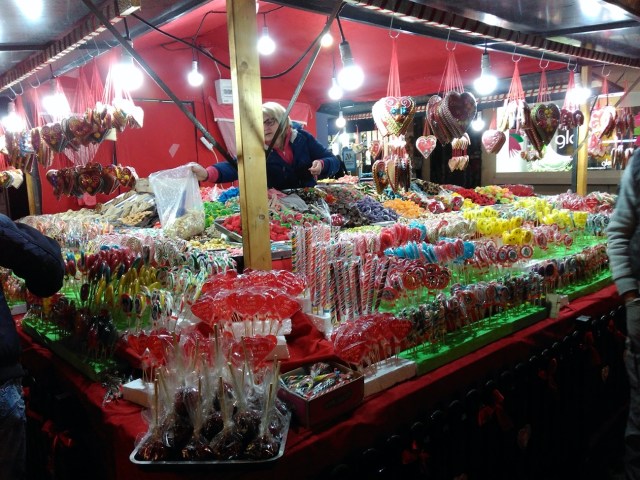
November Activity Report
30 November 2019
Global Japan Office Coordinator
Amari Mino
It’s November. The JLPT is less than a month away on December 1. Since last year, we have been able to receive an increase in the number of university recommendations for government-sponsored study abroad programs. As a result, there has been a noticeable increase in the number of students aiming for N2, which is a condition for applying for these programs. With the opening of a Japanese language course at Karlovci High School (language high school), the number of high school students taking the test is increasing. N1, which had four applicants last year, attracted as many as 10 applicants. Everyone is serious. And from November, the so-called colloquium, which are like midterm exams, will be held for each subject. On average, students take 10 courses, or more, so from November, we will be doing JLPT preparation while also being chased by the colloquiums. In that respect, it must be more stressful than Japanese universities.
◆Doing One’s Best
I’m far from the best. Because I was born with many disabilities, I can’t do things in the same way as most people.
But there is one thing that I always keep in mind. That is to do your best.
And also to give back what you can.
November was really a month of hard work.
I taught 17 classes a week. Of course, I need to prepare for these separately. I didn’t take a day off.
Normal teachers only hold 6 classes, so 11 of mine were extra classes.
Maybe I don’t have to do them.
Actually, I’m the only one doing them.
Serbia still suffers from the effects of internal strife and student activism.
But there is a reason why I can act freely.
I am employed as a coordinator of Global Japan Office by the Tokyo University of Foreign Studies. I have no choice but to break through any barriers as I coordinate. And no one objects to this. While it is an extremely demanding position, I am very grateful for it.
However, I think it is good for students to have one teacher like that.
I was once told, ” Amari-sensei, you don’t seem Japanese.”.
I was surprised and asked, “why?”.
They answered, “because you are free!”
Freedom ……。 In fact, nothing is more painful than freedom. I struggle behind what appears to be freedom.
Even so, I was deeply moved for a while regardless of if I look free or if other Japanese people look reserved to the Serbs. I don’t know if it was a compliment, but I decided to take it as a compliment because I’m optimistic.
Until Saturday, the day before December 1, in addition to our regular private lessons and club activities, I had a class on JLPT tactics. In the end, I prepared all the JLPT tactics by myself.
Although not all the students taking the test participated, a total of about 60 students participated. So many of them passed the exam, and some even passed N1, so this was my greatest source of joy in the past month.
Gradually, November in Belgrade began to shine with beautiful Christmas illuminations.
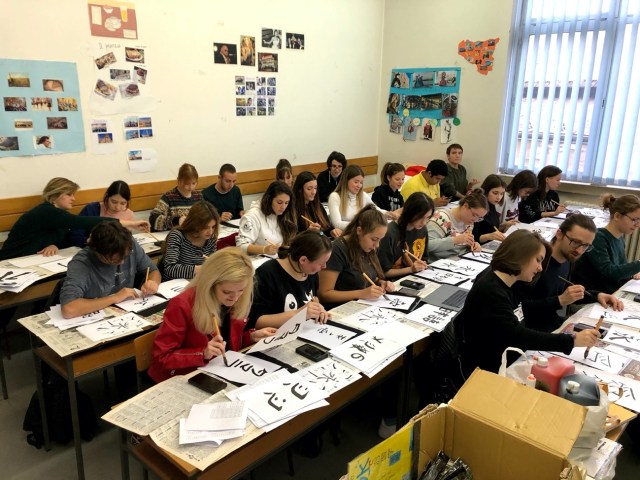
October Activity Report
31 October 2019
Global Japan Office Coordinator
Amari Mino
The summer heat continued on into October, and the start of classes was moved further forward than in previous years. A sports festival is being held for students to pump the country up for the Tokyo Olympics. A new Japanese teacher from TUFS came to teach at the University of Belgrade. They entered graduate school at the same time as I did, so we get along quite well – for which I am very grateful.
◆Second Language Education
I’ll start with my complaints. The Japanese department at the University of Belgrade is strange.
What I mean by this is that it is strangely popular. You can also see this in the acceptance rate of the Japanese course at the language-specialty high school (which is roughly 40%), but Japanese is just too popular.
This is actually a very wonderful thing, isn’t it? I think it is. As a Japanese citizen, this makes me very proud.
At the same time however, I feel bad for the students.
For example, the Spanish department. Their maximum intake is 60 people. This is the same as the intake in the Japanese department. However, in recent years the Japanese department often accepts more than this limit, and last year there were 80 students.
This is fine, but the problems arise after they’ve been accepted. The long-standing Spanish department splits their 60 students into three classes. There are 20 students in each class. For a language learning class, this is still a few too many, but it is within the manageable range.
How about in the Japanese department then? Well, there is one class. And by the way, the classroom is designed to seat a maximum of 36 students. Last year, at first, I squished 80 students into this classroom, but some repeating students also joined the class, so there was an average of 100 students per year group.
Is it possible to even fit 60-80 students in each class?
Technically, yes. The students lined up chairs along the walls of the classroom, and some even sat or stood on the floor when there were not enough chairs. I was impressed by their resolve. I also feel bad that they had to do this.
The students are also not all at the same level. There are students who studied Japanese for four years at the language-specialty high school and have already passed N2 of the JLPT. There are also students who have never studied Japanese before. And of course there are also students who have studied quite a bit on their own.
I have to teach all of these students together in one class.
I suppose it’s not impossible, I can do it.
After all, there were 60 students in the language class I took during my university years. I suppose you could teach a class of this size if you use the grammar-translation method. I don’t use this method though.
This situation is unfortunate. After all, this isn’t a Latin class. It is a class where living students gather to learn a living language, Japanese.
I tried my best with this class. I used to be a kindergarten teacher, and I’ve come to realize that one three-year-old is roughly equivalent to 40 university students. There were 80 students, so that is like two three-year-olds. As long as they understand the class, its fine.
However, this is not a kindergarten. This is a group of highly-intelligent people coming to learn. These students are coming to study in the most popular department of Serbia’s highest institute of education.
This is why I am trying my best.
Naturally, working hard leads to exhaustion. The insufficient number of teachers and classrooms also contributes to this. We can’t even buy real textbooks.
Under these circumstances, I choose to prioritize the students.
For this I apologize, but I have to put this blog at the bottom of my priorities.
Please forgive me. If I don’t do this, I can’t possibly send 10 exchange students to Japan every year.
I would also like you to know that there are students here who really love Japan.
I also know that I am letting down a lot of students. No matter how hard I try, I can’t cater to every student. No matter how many private lessons or extracurricular activities I prepare, I can’t pay adequate attention to every student. All I can do is encourage them not to lose hope.
If I could teach these bright students under better or at least normal conditions, I am sure no one would be as influential to both Serbian and Japanese society as they could be.
They really are a great bunch of students.
I hope you understand my dilemma.
Despite all this, I continue to put my students first.
I want to give all my love to those I love the most.
No matter what people say, I want to give what’s left of my short life to these students.
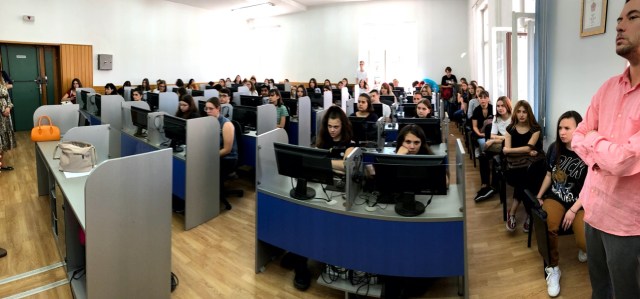
September Activity Report
30 September 2019
Global Japan Office Coordinator
Amari Mino
In the lingering summer heat of September, due to the aggressive “hope” from the undergraduate students, in addition to the usual two times this year, the final exams will be held once more in the Faculty of Letters. So it was a hot September both in name and reality. In addition to the final examinations, the number of applications for the JLPT December examinations, which started in early September, has increased significantly, and the number of examinees is expected to increase in the future. At the same time, the challenge is how to prepare efficiently. When I’m in Serbia, I sometimes feel the enthusiasm of people who want to learn Japanese. I also often meet people who want to travel to Japan someday. I want to value the feelings of these people.
◆How to Support International Students in Japan
September is the month when international students leave for Japan. This year, students traveled to about six universities, including Tokyo University of Foreign Studies.
Among them, there were two foreign students at Tokyo University of Foreign Studies who had to find their own apartment because the university dormitory was not available.
One day in August, a message arrived on my smartphone.
“Please help me!”
It was a message from a student who is scheduled to study at Tokyo University of Foreign Studies from the end of September. This year the university dormitory is not available, so I have to find an apartment and make a contract.
This is the age of the Internet. Serbia also has an internet connection, so it’s easier to find a place than it used to be, and if you’re in trouble, you can get support from the Student Exchange Division, so it might seem easy. In reality, however, Serbia is still in a very difficult situation internationally, so students from here do face problems.
The most difficult thing is money. According to the student, they have to pay a lump sum of over 200,000 yen including the “security deposit”, “key money”, “contract cost”, and “prepaid rent”, which they complained was too much. It’s certainly not an easy price for Japanese, but how much impact does it have for Serbs? Let’s start with the average salary. The average monthly income in Serbia is about 40,000 yen. In other words, their annual income is about 480,000 yen. It is about 1/10 of Japan. In the case of a government-sponsored international students, the expenses for studying abroad are surely paid from Japan. However, it will be some time after they arrive in Japan that they will actually receive the money, and if they rent an apartment, they will have to temporarily pay for it themselves. Considering other expenses at the beginning of their life, they need to spend a lot of money.
Fortunately, their parents saved money for them this time. But for the Serbs, it’s certainly very expensive.
Next, there was the question of whether they would be able to make a contract with a Japanese real estate company from Serbia to secure a property before coming to Japan. Serbia actually exists in Europe, but it is unexpectedly difficult to adapt from Serbia to the Japanese contract customs of “originalism” in all services such as postal services, telecommunications, financial services, etc. Real estate contracts in Japan are difficult procedures for foreigners.
This time, I decided to support them in GJO.
The requests of the two international students were narrowed down to about three points: they wanted to live near the university, they wanted rent to be as good as the dormitory, and they didn’t want to live in a share house. The apartment where I used to live ended up satisfying these three points.
So I talked with the two students.
“I can recommend the apartment I used to live in, but it’s very old. Are you okay with that?”
Then they said, “It’s the place where you lived, so no matter how old it is, we’ll be fine!”.
I was very happy to hear that.
In addition, the landlord arranged two rooms including refrigerators and a gas stoves that they didn’t have when I lived there.
Even renting a hotel and looking for real estate for just a few days after arriving in Japan is very difficult for Serbs financially. There is nothing more reassuring than having your own bed on the day you arrive.
In this way, the cooperation was just right, and the students were able to travel to Japan without feeling uneasy, but without the warm spirit of the landlord, the real estate company that treated them sincerely, and my older sister who supported them with a lot of time and effort and devoted herself to volunteering, it would have been difficult to realize it.
Due to an increase in the number of students studying abroad in the future, there is a possibility that students may not be able to live in dormitories at host universities, not just the Tokyo University of Foreign Studies. Nevertheless, I would like to continue supporting Serbian students in cooperation with Japanese universities so that they can come to study abroad from Serbia with peace of mind.
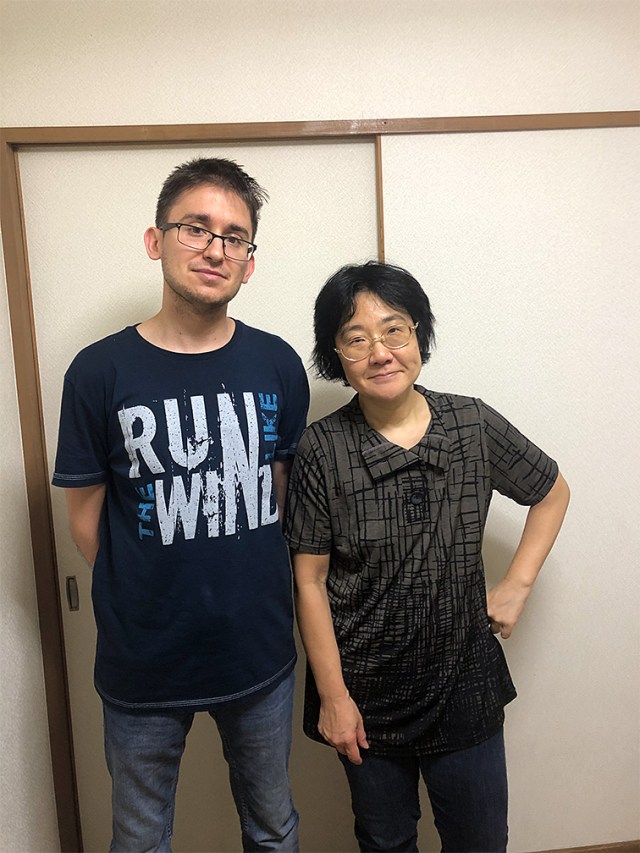
August Activity Report
31 August 2019
Global Japan Office Coordinator
Amari Mino
Belgrade in August was hot, but local people said it was less hot than usual. Even so, although the humidity is low, I felt quite hot for Japanese. Notably, there is no air conditioner in the dorm room of the university, so electric fan is very necessary during the summer. Even so, I was able to enjoy a lot of outdoor sports, for example, mounting and kayaking, and get a very healthy suntan. I thought Serbia in summer is the best season for me, even not willing to return to Japan. Being in Serbia all this summer, I have been able to welcome many guests from Japan. So it has been very fulfilling summer vacation for both the students and me.
◆Students Shining in Summer
Although there were almost no events in July, after August began, then the University of Belgrade started receiving many visitors from overseas.
First, the students from Gakushuin Women’s University visited us. They visit us once every year, and this is their ninth visit to Belgrade University, led by Professor Nakajima. And every time, we hold an exchange meeting with Japanese language students at the University of Belgrade. This year, we were worried about how many students would gather because we had just received a message from them. But as a result, we welcomed 11 students at Gakushuin Women’s University, and nearly 30 students at the University of Belgrade came to host them. I was also happy that students are more fluent in Japanese than in the Japanese language classes.
The party toured the Kalemegdan Fortress and then shopping at the market. We had excellent sightseeing around the university and gathered in the restaurant they had set up for the get-together, literally keeping the exchange warm until after midnight.
The next one we welcomed was a study tour by a club of Keio University, which was the second one after February. A senior sophomore who visited Belgrade in February came back to Belgrade with his juniors. We did not prepare any official events for a visit from Keio University, but we were still able to interact with many students of the University of Belgrade.
There is nothing happier for students studying Japanese in Serbia than the fact that the same generation’s students visit Belgrade. After all, Japan is a very far country for us, and it costs a lot of money to travel. There are officially only 177 residents in Serbia. And only a few of them are Japanese university students. In such a situation, there is nothing more welcome than the opportunity to socialize and interact with so many Japanese university students. I felt happiness supremely when the students’ eyes are shining, and their Japanese words come out more fluently than usual.
At the end of August, there was a massive event at the university. This event is a big event that rarely happens. The name is “The 23rd Japanese Language Education Symposium in Europe” held by AJE, Association of Japanese Language Teachers in Europe. It was the first time for students to experience such a large-scale Japanese language conference.
For months they had been carefully preparing, thinking about writing for a tour guide in Japanese, asking for corrections, and memorizing them all. At the conference venue, they showed their hearts for hospitality by guiding people to the site and offering drinks and sweets during breaks. The Serbians are no less hospitable than the Japanese. It seems to me that they have a powerful spirit of hospitality. The students who survived the three-day conference from early morning to late at night looked very strong. In particular, I felt that their ability to speak more formal and polite Japanese has improved as a result of constant conversation in Japanese with many Japanese-speaking researchers. Thanks to you all, we received a lot of praise from the participants for our students.
Thank you very much to all the participants, students, and staff.
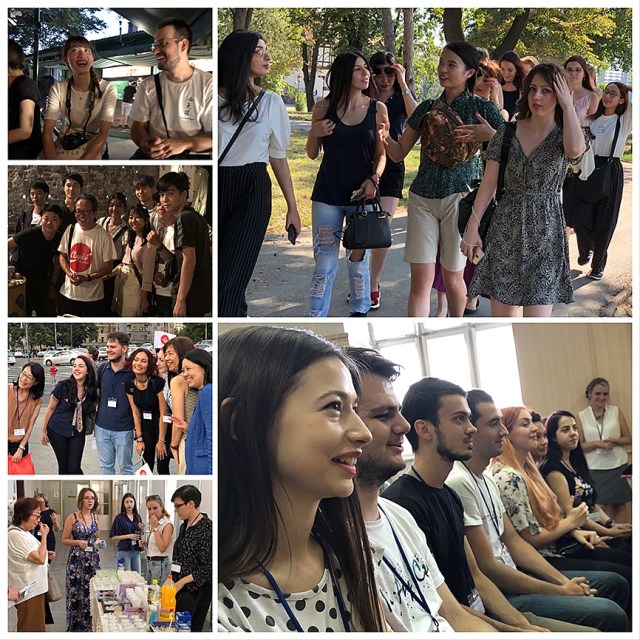
July Activity Report
31 July 2019
Global Japan Office Coordinator
Amari Mino
The hot and rainy June came to an end, and Belgrade became a little cooler in July. According to Serbians, this year’s summer was cooler than usual, and when I think about it, having a fan was enough for me to survive the heat. Going into July, there was still the occasional downpour paired with thunder and lightning, so I have been constantly carrying an umbrella with me. Final exams at the University were held in the first half of July, after which the long summer vacation began. The university will be closed during this time. I will be spending my entire summer in Serbia, living in the university dormitory, but the students have all left, so it is very quiet. Also, different from Japan, cicadas don’t sing during the summer. I realized that this is probably the biggest difference between Japanese and Serbian summers. There is a lot of nature surrounding Belgrade, so I have been enjoying my summer by hiking in the mountains and going kayaking in the Danube river. One thing Japanese and Serbian summers do have in common though is the amount of mosquitoes.
◆Japanese in Serbian Public Education
There were no club activities or events this month, and talking about exam results is not very interesting, so I want to talk a little about Japanese language education in Serbia’s public education system.
Currently, the biggest Japanese language education institution in Serbia is none other than the University of Belgrade. There are around 320 Japanese language majors spread over four year levels, and around 110 students taking Japanese as a minor. It is actually surprising that there are 430 students in Serbia that have such a keen interest in studying Japanese language and culture.
Japanese language majors at the University of Belgrade have been using the “Elementary Japanese” and “Intermediate Japanese” textbooks made by TUFS. I think these are very well-made textbooks, but you can’t deny the fact that they are a getting a little old. The students also know this, and have been wanting new textbooks.
Right at this time, a new textbook called “Tomodachi” was made as a successor to “Elementary Japanese”. It’s a brand new book, so it feels quite fresh. I had actually just heard about this book directly from Professor FUJIMORI Hiroko before I came to Serbia, so I decided to try it out with my first and second-year students. As a result, the textbook received a lot of praise from the students, so I decided to officially introduce “Tomodachi” to the curriculum starting from the new academic year in October 2019. This is a welcome change, as the students will be more motivated with a new textbook, and it is also easy to use, so it makes things easier for teachers too. However, a number of supplementary teaching materials for “Elementary Japanese” are still being developed. I hope that these materials can be used with “Tomodachi” to further improve its content.
So this is what has been happening at the university, now I want to talk about high school education. I’ve written about this a little in prior reports, but in Serbia there are special “language specialty high schools”. Currently there are only two in the entire country, which are the Philological High School of Belgrade in Belgrade, and the Karlovci Gymnasium in Sremski Karlovci. The Karlovci Gymnasium established a Japanese course in October 2018. These schools both use the textbook “Minna No Nihongo”. The students who come to the University of Belgrade from these schools are very good at Japanese, and never fail to impress me.
The Japanese Promotion Project, a collaborative project between Mitsubishi Corporation, the Japanese Embassy and the University of Belgrade, has also been happening for the past few years in Serbia. At the height of this project, Japanese classes were being held at 17 different high schools. This project was successful, as many students who took the classes offered by the project then went on to study Japanese at the University of Belgrade, and some even earned the opportunity to study abroad in Japan. It also had great significance for the careers of those who studied Japanese at the University of Belgrade.
However, as I mentioned previously, the Japanese Promotion Project has come to an end for now. Due to this, I was anxious that the Japanese language’s newfound popularity in Serbia would cool down, but actually I am happy to report that it has been decided that Japanese will be offered as an elective subject at high schools all throughout Serbia. While I’m not sure exactly how many schools it will be offered at, I think that having Japanese as an official elective subject will have an immeasurable impact on the presence of Japan in Serbia. Perhaps this will solve the problem of University of Belgrade Japanese majors not being able to find jobs that utilize their language skills after graduating.
While not much is known about Serbia in Japan, Serbian students are looking on at Japan with ambition in their eyes. They are dreaming of Japan. I think that our duty as Japanese teachers is to help these students grow and to nurture their dreams so they don’t shatter before them. I think that there is no greater happiness than going to a distant land and finding that people love your country’s language and culture. I hope that people keep supporting Japanese promotion activities in Serbia.
June Activity Report
30 June 2019
Global Japan Office Coordinator
Amari Mino
In June, Serbia seemed to suddenly enter a heat wave. The days seemed to continuously reach over 30 degrees, and many nights it would suddenly pour down with rain, thunder and lightning, which caused flooding in the lowlands. The weather in Serbia this year is a little abnormal. Anyhow, classes ended in May for the academic year, and final exams began in June. Since many exchange students’ exchange programs end in June, there were a few farewell parties. The university’s entrance exam was also held in June. I realized that this is a season where many things change in Serbia. There are many large renovations happening around the city, and it seems that Belgrade’s new townscape will be here by fall. Despite the heat, many people are enjoying themselves, perhaps as a warm up for the summer vacation starting in July.
◆Philological High School of Belgrade’s School Festival
In Serbia, there is a special kind of high school called a “language specialty high school”. As of 2019, two of these schools exist. One is the Philological High School of Belgrade, which has had a Japanese course for many years, and the other is a school in the nearby city of Novi Sad, which began offering a Japanese course in October 2018.
Speaking of this high school and its deep ties to the University of Belgrade, TUFS student KAMEDA Mana, who is studying Serbian on exchange at the University of Belgrade, has visited there many times this year as a volunteer to give presentations on Japanese culture and interact with the students.
Through this I met some of the teachers at the Philological High School of Belgrade, and was invited to their school festival. So on June 22, I attended this festival together with a different TUFS student, FUNAKI Sakino.
The school year is almost over for the students at the Philological High School of Belgrade, so they were feeling quite relaxed, and happily entertained visitors underneath the hot sun by introducing Japanese culture, serving okonomiyaki and tea, and singing Japanese songs on the stage.
Students from other courses also worked at the festival. There are 10 different language courses at the Philological High School of Belgrade, so it was fun to try the different foods and walk around the booths – I had a very delicious time. Anyone who has been to the TUFS Gaigosai Festival would probably see quite a few similarities.
This year, first and second-year students from the Japanese course took to the stage and performed TAKEUCHI Maria’s song, “Plastic Love”. A while ago, some students from the Philological High School of Belgrade came to the Pera Pera Café, a Japanese conversation club at the university, and after I told them I often listen to Takeuchi Maria, a few of them got very excited, exclaiming “I know her!” It seems that the students of the Japanese course were researching Japan’s 1970s and 80s for their panel presentation for the festival, and had been practicing her songs as part of that. I think it’s quite a difficult song, but the students managed to sing it well, and was voted 2nd place by the students out of all the performances at the festival.
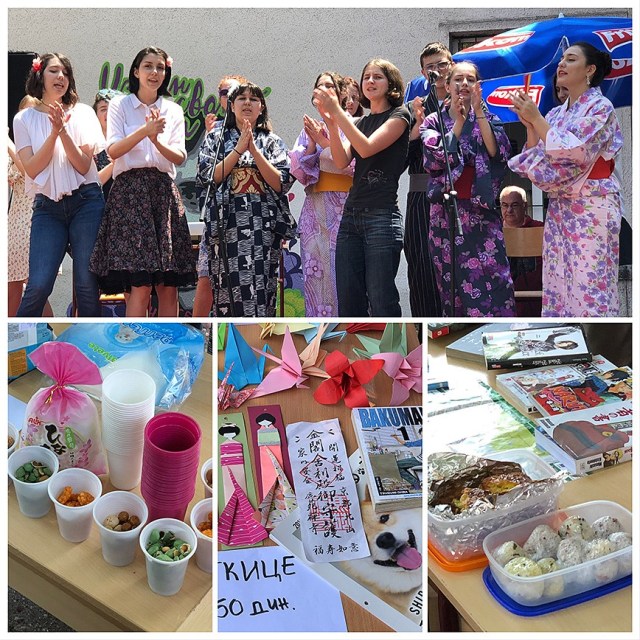
May Activity Report
31 May 2019
Global Japan Office Coordinator
Amari Mino
I had heard that May in Belgrade is warm enough to just wear a t-shirt every day, but this year there were many cooler days and it rained often, so it more or less felt like Japan’s rainy season. The university is located in the center of Belgrade’s old town near the Republic Square, which is currently being renovated for the first time in a few hundred decades. Because of this, many of the surrounding roads are blocked, and traffic has worsened. I have been walking 4km every day to a far off bus stop, which is good exercise but not ideal on rainy days or days I have a lot of luggage. Despite this, I am looking forward to seeing the beautiful new center of Belgrade.
◆Public Diplomacy from Japan
For 10 days from the end of April to the start of May, we had Easter and May Day holidays, during which a Japanese cultural group visited Belgrade.
This group was mainly run by YOSHIDA Kaori, who gave an okonomiyaki (savory pancakes) demonstration, and shamisen songwriter NATSUMI Yuzu, who gave a performance.
This event was held 80km away from Belgrade in Novi Sad, the second largest city in Serbia. It was held on both May 3 and 4, and the same okonomiyaki demonstration and shamisen performance were also held on April 29 at the University of Belgrade.
Despite coinciding with the Easter break, quite a few students attended this event, and everyone seemed to gaze at their first okonomiyaki demonstration in awe – many students even asked for seconds. Also, it seems that for many students this was their first time both seeing and hearing a shamisen, so it was a very interesting experience for them. The event was even covered by a television station.
This event was an example of Japanese public diplomacy. Yoshida Kaori loves Serbia, and personally organized and held this event. I was very moved by her energetic initiative.
By the way, apparently the event in Novi Sad (May 3-4) was extremely popular, and there were over 600 orders of okonomiyaki during these two days. I visited Novi Sad for the first time ever on May 4, and popped in for some okonomiyaki whilst sightseeing. I was very touched that day after seeing how many people in Novi Sad are interested in Japan.
◆Pera Pera Café
At the University of Belgrade, a Japanese conversation club called the “Pera Pera Café”, a Book Club and a Calligraphy Club are held as club activities, with the Pera Pera Café currently being the most popular.
I usually have various special guests visit the Pera Pera Café each time we meet, and recently I’ve even had requests from Serbian people who wish to join as guests, as opposed to just Japanese people.
For example, I’ve had requests from people studying Japanese at language schools who wish to have their first interaction with Japanese people. These types of students are learning Japanese from Serbian Japanese language teachers, and had their first conversations with Japanese people through participating in the Pera Pera Café. They were, of course, very nervous at first. Despite this, once they realize they can actually have conversations with the Japanese they have learnt, they will become much more relaxed and “pera pera” (fluent). They also seemed to enjoy speaking to other Serbians in Japanese, and got really hyped up during a conversation about their hobbies.
Aside from this, quite a few high school students from the nearby Philological High School of Belgrade have been attending the club’s meetings. Quite a few students in the University of Belgrade’s Japanese Language, Literature and Culture Department came from this high school, so it is encouraging for the high schoolers to talk with them. As expected of a language-focused school, the students of the Philological High School of Belgrade can speak quite a bit of Japanese, and aren’t too nervous to do so, but even they seem quite happy, exclaiming “I was able to use different Japanese than usual!” This made me feel a little nervous, and that I must hold good classes, as I hope to live up to the expectations of these high school students that have their sights set on studying Japanese further at the University of Belgrade.
The Pera Pera Café is open to any Japanese people, whether they are studying or working in Serbia, or just visiting. If this sounds up your alley, please contact me. I think we could have a really good time together.
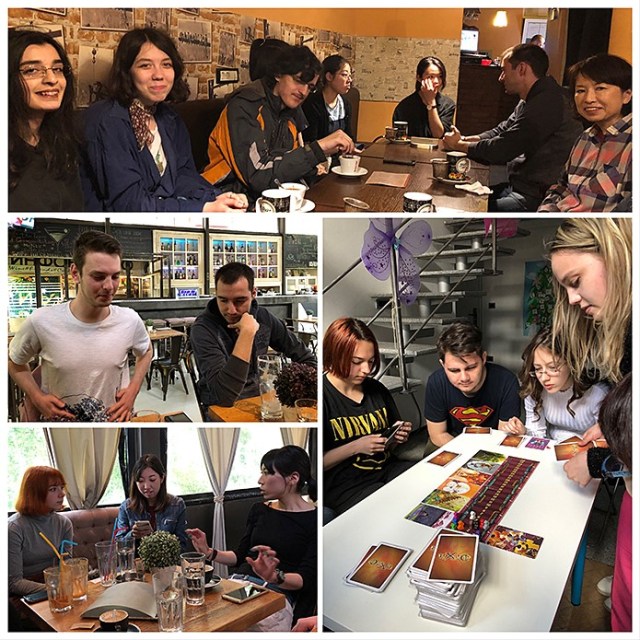
April Activity Report
30 April 2019
Global Japan Office Coordinator
Amari Mino
Going into April, the cherry blossoms gradually fell from their branches, springtime flowers bloomed one after another, and unlike the beautiful white world of winter, a colorful world brimming with power began to unfold. In the latter half of the month, Easter preparations began. Eastern Orthodox Easter is celebrated one week later than Christian Easter, and celebrations in Serbia seemed to last for a long time, similar to Christmas and New Year celebrations (which are also held a week later than in Christian countries).
◆Private Lessons
Unlike Japan, April at the University of Belgrade is neither the start of a new semester nor a new academic year, but rather is the middle of the academic year’s second semester, so students were studying diligently during this month.
One particularly ambitious student reached out to me, and the private lessons I began offering this year started going to plan.
Currently, the University of Belgrade’s Japanese Language, Literature and Culture Department is experiencing a rapid increase in students, so there are a large number of students in each class, which is not an ideal environment for language learning – but this doesn’t mean that students should give up.
I have been organizing opportunities as needed to teach students things that we couldn’t cover during class, such as club activities (conversation, reading, calligraphy), lectures with special guests from Japan, and cultural events.
In addition to these, I have been holding private lessons suited to the individual needs of each student, which, as a teacher, have been very interesting for me.
As of recent, many students have been coming to my private lessons in small groups with their friends, usually groups of four at the most, so the lessons have been quite harmonious and friendly in nature.
As for the content of these private lessons, many students ask me to help them prepare for the JLPT (Japanese Language Proficiency Test), but I have told the students that anything is okay, and so occasionally I have irregular lessons where we decide on a topic and focus on that alone.
For example, if a student asks me for a private lesson on “basic honorific language”, then I would focus fully on teaching them the basics of honorific/polite language, and if a student came to me saying “the weather is so good, let’s go for a walk around Belgrade Fortress”, then I would go on a field trip with the student to the fortress, which is near campus, and ask them to guide me in Japanese.
As the students get used to me and these lessons, it becomes easier for them to ask for more personalized lesson content, and I have even received requests that I never would have thought of, which is quite surprising and exciting for me as a teacher. I hope the students continue coming to me with ideas for their private lessons.
I am really enjoying my days learning together with these bright and energetic students.
